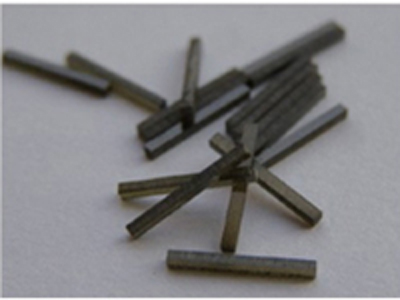

CVD diamond thick film cutter in Abrasives needs to be firstly cut and then is welded onto the matrix (usually the K-type cemented carbide) once, forming composite film. And we need to polish the composite film, secondary welding on cutter body and grind it into the required shape and edge.
The manufacturing process: the preparation of high quality CVD diamond film → laser cutting → welding once into composite film → composite film polishing →secondary welding on cutter body → tool grinding→ inspection. Here are a few key processes, such as cutting, welding, polishing, grinding, etc.
A. Laser cutting
CVD diamond film is non-conductive (conductive CVD diamond’s resistivity is high) with high hardness and strong wear resistance. Conventional machining and linear cutting method are not suitable for the cutting of CVD diamond thick film. The most efficient processing method is laser cutting.
B. Welding once
Welding once means CVD diamond thick film is welded on some matrixes forming composite films under vacuum conditions. The weld ability between diamond and metal is quite poor. At present, the welding technology of diamond thick film cutters mainly adopts the method of surface metallization. Welding flux is silver copper alloy containing titanium, and titanium is used to react to diamond film surface in the process of welding and heating, producing TiC interlayer, which makes diamond film surface metallization in order to improve the welding strength. Welding matrix is usually K-type cemented carbide. Under the condition of high vacuum, Ag, Cu, Ti alloy as the interlayer, diamond thick film is welded on cemented carbide substrates by using diffusion welding and brazing process, whose weld strength can meet the machining requirements.
C. Composite film polishing
The purpose of polishing is to polish the blade surface (i.e. the rake face) into mirror surface, whose general requirements are under Ra0.1 um. The rake face of cutters can reduce the friction and bonding with cuttings after polishing, and extend the service life of cutters; At the same time, it can also improve the smoothness and sharpness of blades, and improve the machining precision. Composite film polishing needs to use special polishing machine.
D. Secondary welding
Secondary welding means to weld composite film on cutter body. Equipments used for that are high frequency induction welding equipments, and used welding flux is silver copper and brazing flux. Welding temperature is between 650~700 degrees and can not be too high. The welding surface should be kept clean in the welding process. Right brazing flux can improve the welding strength and improve the welding performance of composite film substrate and blade materials. Generally, the strength of secondary welding will be of 180~200MPa that can satisfy the requirements of diamond cutters machining. In addition, in order to improve the appearance of the cutters, we can use oil stones to wear off the excess silver copper, remove surface oxide layer with sand blasting method, and prevent the oxidation of blade rust by means of the soaking passivation solution.
E. Tool Grinding
Tool grinding for CVD diamond needs high hardness and wear resistance, which is extremely difficult. Currently the widely used means is the tool grinding method like tool grinding of PCD cutters. It needs to add cooling fluid when in grinding process, and should be paid attention to the grinding wheel dressing. Usually, it can improve the tool grinding efficiency and tool grinding quality by using suitable oil stones correctly dressing grinding wheel. Due to the impact resistance of CVD diamond inferior to that of PCD diamond, some cutters after tool grinding should be rounding sharp edge for 0.02~0.03 mm.
F. Inspection
The edge quality inspection of cutters usually is observed by microscope of 40~80 times magnification. The blade serrate degree of ordinary cutters is less than or equal to 0.02 mm. For cutters with higher precision, its blade serrated degree is less than or equal to 0.005 mm after grinding and polishing. In addition, different workpiece materials have different quality requirements for cutters edge. Tool grinding CVD diamond cutters should start from practical application situation. Blindly pursuing high quality cutting edge not only reduce the production efficiency, but also increase the cost of production.